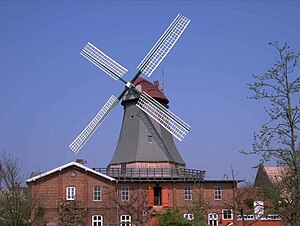Rönn Mill
| Rönn Mill
|
||
|---|---|---|
|
Mill by Rönn in Osterholz-Scharmbeck |
||
| Location and history | ||
|
|
||
| Coordinates | 53 ° 13 '47 " N , 8 ° 47' 26" E | |
| Location | Lower Saxony , Osterholz district , Osterholz-Scharmbeck , Scharmbeck | |
| Built | 1882 | |
| Shut down | 1939 | |
| Status | repurposed | |
| technology | ||
| use | ||
| Windmill type | Gallery Dutch | |
| Number of wings | 4th | |
| Tracking | Compass rose | |
The Rönn Mill is a historic mill in Osterholz-Scharmbeck . The facility at Lindenstrasse 40 defines the cityscape and is one of the landmarks of Osterholz-Scharmbeck. The facility was built in the 1880s and is now used as a cultural center.
geography
The mill stands exposed at one of the highest points in the city and can be seen from afar. There is also a Meteomedia AG weather station for the city of Osterholz-Scharmbeck at the location .
Further windmills can be found at the harbor in the Osterholz district (but without blades ) and in the Sandhausen-Myhle district (from 1795).
history
There are various details about the creation of the system:
A source says that it began operations on December 14, 1882. The plant was built by master miller W. Peters from Hanstedt on one of the highest points in what was then Scharmbeck . In December 1886 a heavy storm destroyed the four mill wings and a year later Peters moved to Otterndorf and handed the mill over to the new owner JD Steffens. The mill quickly changed hands again in 1888 and today's namesake Wilhelm von Rönn bought the mill. In 1895 his brother Albertus von Rönn took over the mill. He also held political offices and was first elected in 1908 as "Mayor 3rd Class", in 1909 in the magistrate, in 1910 as 1st councilor and in 1929 as member of the state parliament in Hanover .
According to other information, the mill was placed on top of an existing house in 1882/83. It is said to have been a two-story four-speed Dutch mill with a wind turbine made of five blades and without a gallery and compass rose. It was only after 1888 that the von Rönn family converted it to four wings.
In 1911 a compass rose was added and in 1937 wind power was initially supplemented by gas and later by several electric motors. At the same time, the mill was given modern blades (so-called Ventikanten) for the conditions at the time, thereby improving its grinding capacity. In 1939 a hurricane destroyed the mill cross and from that point on the grinding aisles were only powered electrically. In 1958, a new wing cross with so-called sail gate wings was put on. However, this was no longer used for grinding.
A fundamental renovation began in 2002, and in 2004 the city concluded a usage contract with the citizens' association, which set up a mill museum in the mill building.
The mill today
The mill was renovated in the 1990s on a private initiative and expanded into a mill museum. In 1993 the Osterholz Biological Station (BioS) moved into the main building and uses it with 20 full-time and voluntary employees.
Meteomedia AG has been using the location (on and in front of the mill) for a weather station since 1998 .
The Maribondo da Floresta Foundation has been running the Mühlencafé since December 2006 .
literature
- Friedrich Kühlken : Between Niederweser and Niederelbe - A local history of the state of Bremen and the Lower Saxony district of Stade. Osterholz-Scharmbeck 1950.
- Reelf Menckhoff: Chronicle of Osterholz-Scharmbeck - Volume 1: From the beginnings to 1929. City of Osterholz-Scharmbeck 2004.
Web links
- www.deutsche-muehlen.de - Information about mills
- Profile of the mill - niedersaechsische-muehlenstrasse.de
- nordwestreisemagazin.de: Small mill customer
- www.muehlen-dgm-ev.de German Society for Milling Customers and Mill Maintenance (DGM) e. V.
swell
- ^ R. Menkhoff: Chronicle of Osterholz-Scharmbeck Volume 1

